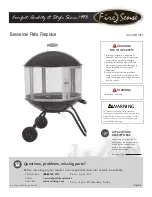
A
DJ & DG MANUAL
7 of 34
May 12 R2
2.
This unit shall be electrically grounded in accordance with the latest edition of the National
Electrical Code (ANSI/NFPA 70), State and Local Codes and in accordance with the local
authorities having jurisdiction.
3.
If the unit has not been provided with an electric disconnect switch, one of adequate ampacity shall
be installed in accordance with Article 430 of the National Electrical Code (ANSI/NFPA 70).
4.
The installation of this unit shall be in accordance with the latest edition of the National Fuel Gas
Code ANSI/Z223.1/NFPA 54, State and Local Codes and in accordance with the local authorities
having jurisdiction.
5.
In accordance with local authorities having jurisdiction or NFPA 54 an accessible approved manual
shutoff valve shall be installed within 6 ft (1.8 m) of the valve train (gas manifold).
6.
The installation of this unit shall be in accordance with the latest edition of the National Standard
Plumbing Code (NSPC), State and Local Codes and in accordance with the local authorities having
jurisdiction.
7.
The installation of this unit shall be in accordance with all other National, State and Local
Codes, and in accordance with the local authorities having jurisdiction.
MINIMUM CLEARANCE TO COMBUSTIBLES AND FOR SERVICE IN INCHES (mm)
COMBUSTIBLE CLEARANCE
SERVICE CLEARANCE
MODEL
TOP
FRONT
BACK
SIDE
BOTTOM
FLUE
OPPOSITE
BURNER
SIDE
SERVICE/
BURNER
SIDE
CONTROL
PANEL †
DJ(E,S) INDIRECT
FIRED GAS HEAT
6"
(152)
6"
(152)
6"
(152)
1"
(25)
0
9"
(229)
NA
24" (610) 42" (1067)
DG INDIRECT
FIRED GAS HEAT
6"
(152)
6"
(152)
6"
(152)
1"
(25)
0
9"
(229)
NA
24" (610) 42" (1067)
INDIRECT FIRED
OIL HEAT
6"
(152)
6"
(152)
6"
(152)
1"
(25)
0
9"
(229)
18"
(457)
24" (610) 42" (1067)
FLUID COILS &
RECOVERY
DEVICES
1"
(25)
1"
(25)
1"
(25)
1"
(25)
0
NA
NA
UNIT
WIDTH
42" (1067)
ELECTRIC HEAT
1"
(25)
1"
(25)
6"
(152)
1"
(25)
0
NA
NA
UNIT
WIDTH
+ 10" (254)
42" (1067)
OTHER (NON
GAS) UNITS
1"
(25)
1"
(25)
1"
(25)
1"
(25)
0
NA
NA
24" (610)
42" (1067)
† - As required by the Canadian Electrical Code or the National Electrical Code.
For Safety and Service, the minimum clearances must be observed. Minimum clearances also provide
adequate combustion air supply.








































